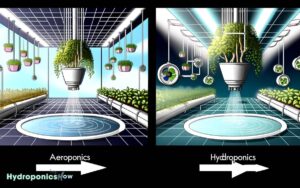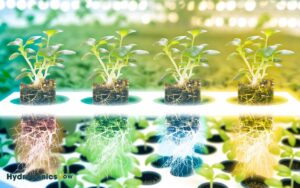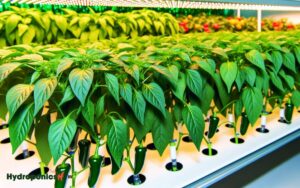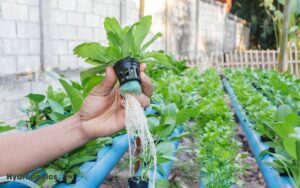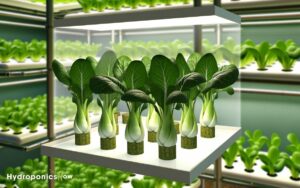Types of Hydroponic System Design: Exploring the Options!
Hydroponic system designs include several advanced methods. Deep Water Culture (DWC) suspends plant roots in oxygenated, nutrient-rich water.
The Nutrient Film Technique (NFT) circulates a thin layer of nutrient solution over roots, boosting oxygenation.
Ebb and Flow systems periodically flood roots with nutrients, ensuring robust oxygenation and consistent growth.
The Wick System uses capillary action to deliver nutrients to smaller plants with minimal maintenance.
Drip Systems offer precise nutrient delivery via a tube network, maximizing efficiency.
Each method suits different crop types and scalability needs. Explore these systems to find the best solution for your hydroponic ambitions.
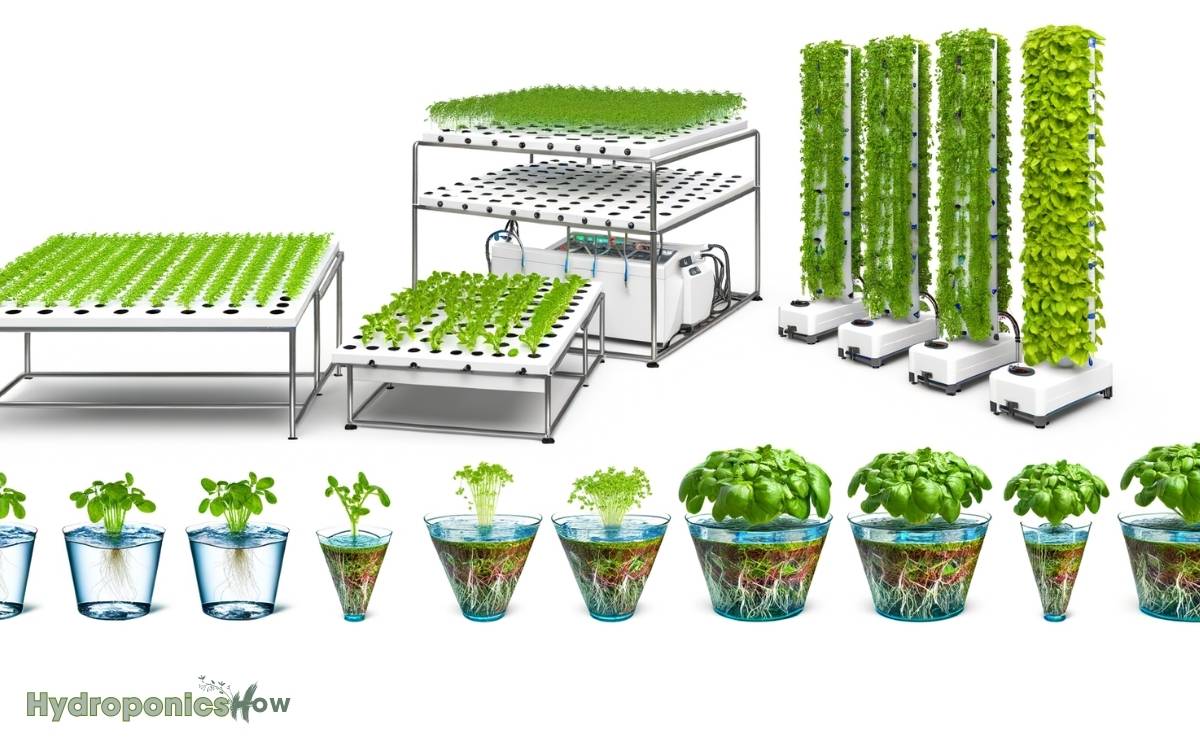
Key Takeaways
Deep Water Culture (DWC)
Deep Water Culture (DWC) is a hydroponic method where plant roots are suspended in a nutrient-rich, oxygenated water solution, creating ideal growth conditions.
This system relies on continuous aeration provided by air stones, which guarantees dissolved oxygen levels remain at their best for root respiration.
The use of a non-porous container helps maintain consistent water levels and nutrient concentrations, minimizing fluctuations that could stress plants.
One of the key advantages of DWC is its simplicity; it requires fewer moving parts compared to other hydroponic systems, reducing maintenance requirements.
Moreover, the direct access to nutrients and oxygen facilitates rapid growth and higher yields. Ideal for leafy greens and herbs, DWC systems are scalable, making them suitable for both hobbyists and commercial growers.
Nutrient Film Technique (NFT)
The Nutrient Film Technique (NFT) operates by continuously circulating a thin film of nutrient-rich solution over the plant roots, ensuring constant nutrient availability.
This method enhances root oxygenation, as the shallow stream allows for greater exposure to air. Consequently, NFT systems can achieve rapid plant growth and higher yields due to optimized nutrient and oxygen delivery.
Constant Nutrient Flow
Among various hydroponic methods, the Nutrient Film Technique (NFT) stands out for its efficient use of water and nutrients, providing a thin, continuous flow of nutrient solution to plant roots.
This technique involves a slight tilt in the channels, enabling gravity to pull the nutrient solution across the root zone, ensuring consistent exposure.
The constant nutrient flow minimizes the risk of nutrient imbalances and efficiently recycles water, reducing overall consumption.
The root systems are periodically wetted yet remain mostly aerated, preventing root rot. Precision in maintaining the nutrient film’s depth is essential; too shallow a film may lead to inadequate nutrient absorption, while too deep a film can suffocate roots.
NFT systems are particularly suited for lightweight, fast-growing crops.
Root Oxygenation Benefits
One of the core advantages of the Nutrient Film Technique (NFT) is its ability to enhance root oxygenation, an essential factor for ideal plant growth and health.
In NFT systems, a thin film of nutrient solution continuously flows over the roots, which are suspended in the air.
This configuration allows for excellent gas exchange, ensuring that roots receive ample oxygen while simultaneously absorbing essential nutrients.
The thin nutrient layer minimizes waterlogging, which can lead to root rot and other anaerobic conditions. Enhanced root oxygenation promotes robust root development and improves overall plant vitality.
Ebb and Flow
Ebb and Flow systems operate through a flood and drain cycle that periodically immerses plant roots in nutrient solution, promoting ideal nutrient uptake and oxygenation.
Key components required for this system include a growing tray, reservoir, submersible pump, and a timer to control the flooding intervals.
This design guarantees that plants receive essential nutrients while preventing root saturation and promoting robust growth.
Flood and Drain Cycle
The Flood and Drain Cycle, also known as Ebb and Flow, is a highly efficient hydroponic irrigation method that alternates between flooding the root zone with nutrient-rich solution and draining it back to a reservoir.
This cyclical process guarantees ideal oxygenation and nutrient uptake, promoting vigorous plant growth.
The flooding phase allows roots to absorb essential nutrients, while the draining phase prevents waterlogging and encourages aeration.
Precision in timing and frequency of cycles is essential for maintaining ideal root health and preventing issues such as root rot.
This method is adaptable to various plant types and can be fine-tuned to meet specific growth requirements, making it a versatile choice for both commercial and hobbyist growers.
System Components Needed
An effective Ebb and Flow system requires several critical components. These include a grow tray, a reservoir, a submersible pump, and a timing mechanism to regulate the flood and drain cycles.
These elements work in concert to guarantee the best nutrient delivery and oxygenation for the plants.
- Grow Tray: This is where the plants are housed. It must be durable and have adequate drainage capabilities.
- Reservoir: This holds the nutrient solution and should be large enough to supply sufficient nutrients for the entire grow cycle.
- Submersible Pump and Timer: The pump moves the nutrient solution from the reservoir to the grow tray, while the timer ensures precise control over the flooding intervals.
Understanding these components is essential for maintaining an efficient Ebb and Flow hydroponic system.
Wick System
Among the simplest and most cost-effective hydroponic systems, the wick system utilizes capillary action to deliver nutrient solution to the plant roots.
This system comprises a growing medium, often perlite or vermiculite, and an absorbent wick, typically made of nylon or cotton, which connects the nutrient reservoir to the plant roots.
The medium retains moisture while the wick continuously draws nutrients upward, ensuring a consistent supply.
This passive system requires no pumps, making it highly reliable and low-maintenance. However, its efficiency is limited by the wick’s absorption capacity, making it suitable for smaller plants with low water demands.
Proper wick selection and placement are critical to avoid issues such as nutrient imbalances or root drying.
Drip System
Utilizing precise control over nutrient delivery, the drip system offers a versatile and efficient method for hydroponic cultivation, suitable for a wide range of plant sizes and types.
This system employs a network of tubes to deliver nutrient-rich water directly to the base of each plant, ensuring ideal uptake and reducing waste.
Key advantages of the drip system include:
- Scalability: Easily adaptable for both small-scale and commercial operations.
- Customizable Nutrient Delivery: Enables tailored nutrient solutions for specific plant needs.
- Water Efficiency: Minimizes water usage by directing nutrients precisely where needed.
The drip system’s ability to provide consistent moisture and nutrient levels contributes to enhanced plant growth and yield, making it a preferred choice for many hydroponic growers.
Aeroponics
Building on the principles of controlled nutrient delivery observed in drip systems, aeroponics elevates plant cultivation by suspending roots in an air or mist environment, allowing for maximum oxygen exposure and nutrient absorption.
This method employs a fine mist of nutrient solution, directly targeting the root zone, and thereby ensuring ideal growth conditions.
Aeroponics systems are highly efficient, using minimal water and nutrients while promoting rapid plant growth and high yields. The precision delivery of nutrients reduces waste and mitigates potential root diseases.
| Advantages | Disadvantages | Applications |
|---|---|---|
| High Oxygenation | Requires Technical Skill | Commercial Farming |
| Efficient Use of Water | High Initial Cost | Research Facilities |
| Rapid Growth Rates | Risk of Pump Failure | Urban Agriculture |
| Disease Prevention | Constant Monitoring | Vertical Farming |
This system is ideal for advanced growers seeking to maximize efficiency and output.
Conclusion
In summarizing the various types of hydroponic system designs, each method offers distinct advantages and challenges tailored to specific cultivation needs. The selection of a suitable system depends on factors such as space, crop requirements, and available resources. Additionally, growers must consider the types of hydroponic substrates used, as these materials play a crucial role in water retention, aeration, and nutrient delivery. By carefully evaluating these elements, cultivators can optimize plant growth and maximize yields.
The types include Deep Water Culture, Nutrient Film Technique, Ebb and Flow, Wick System, Drip System, and Aeroponics. What drives the selection of one system over another?
The answer lies in the specific requirements of the plants, available resources, and desired efficiency.
Understanding these systems’ intricacies guarantees top plant growth and resource management in hydroponic agriculture.


